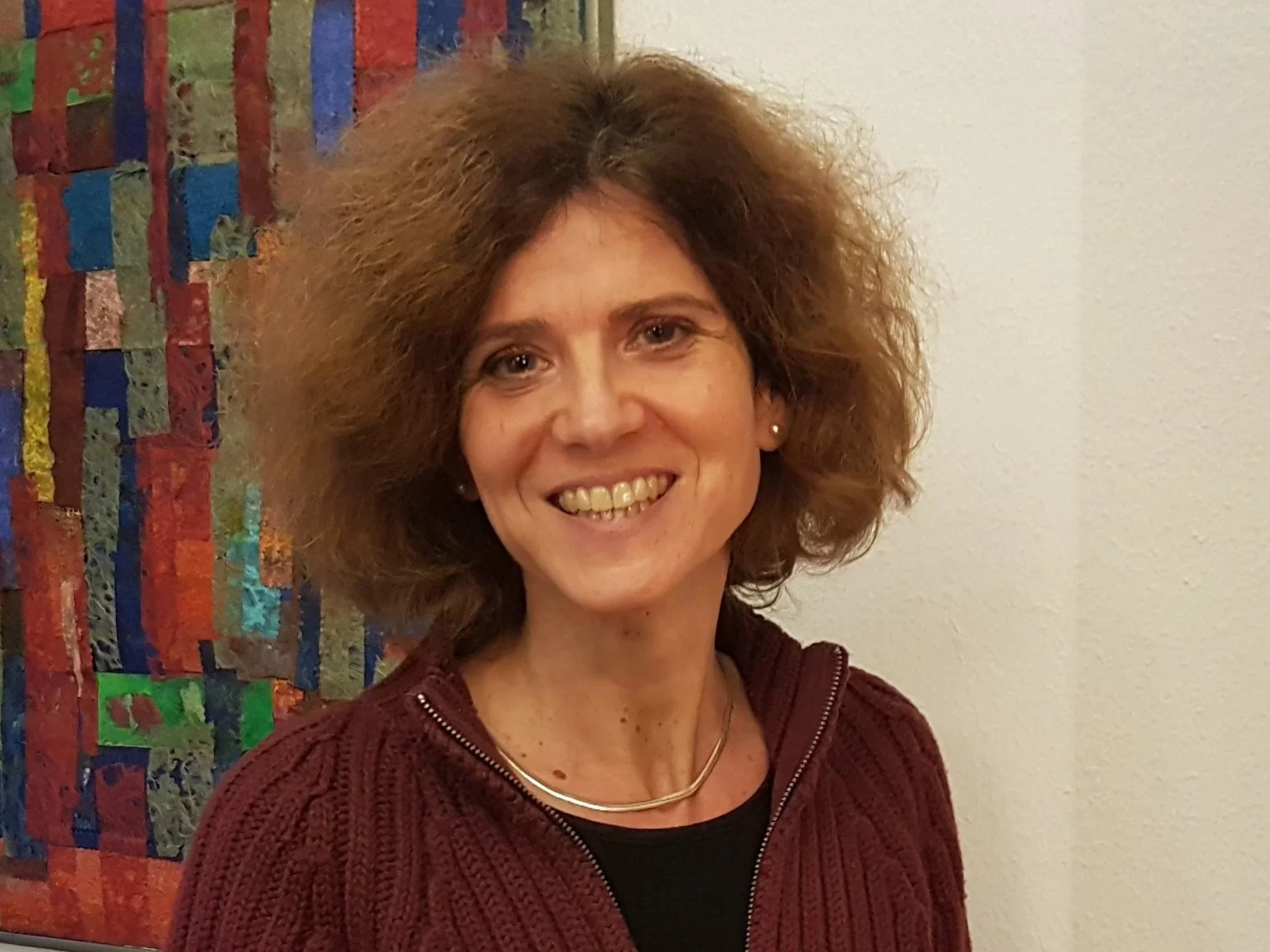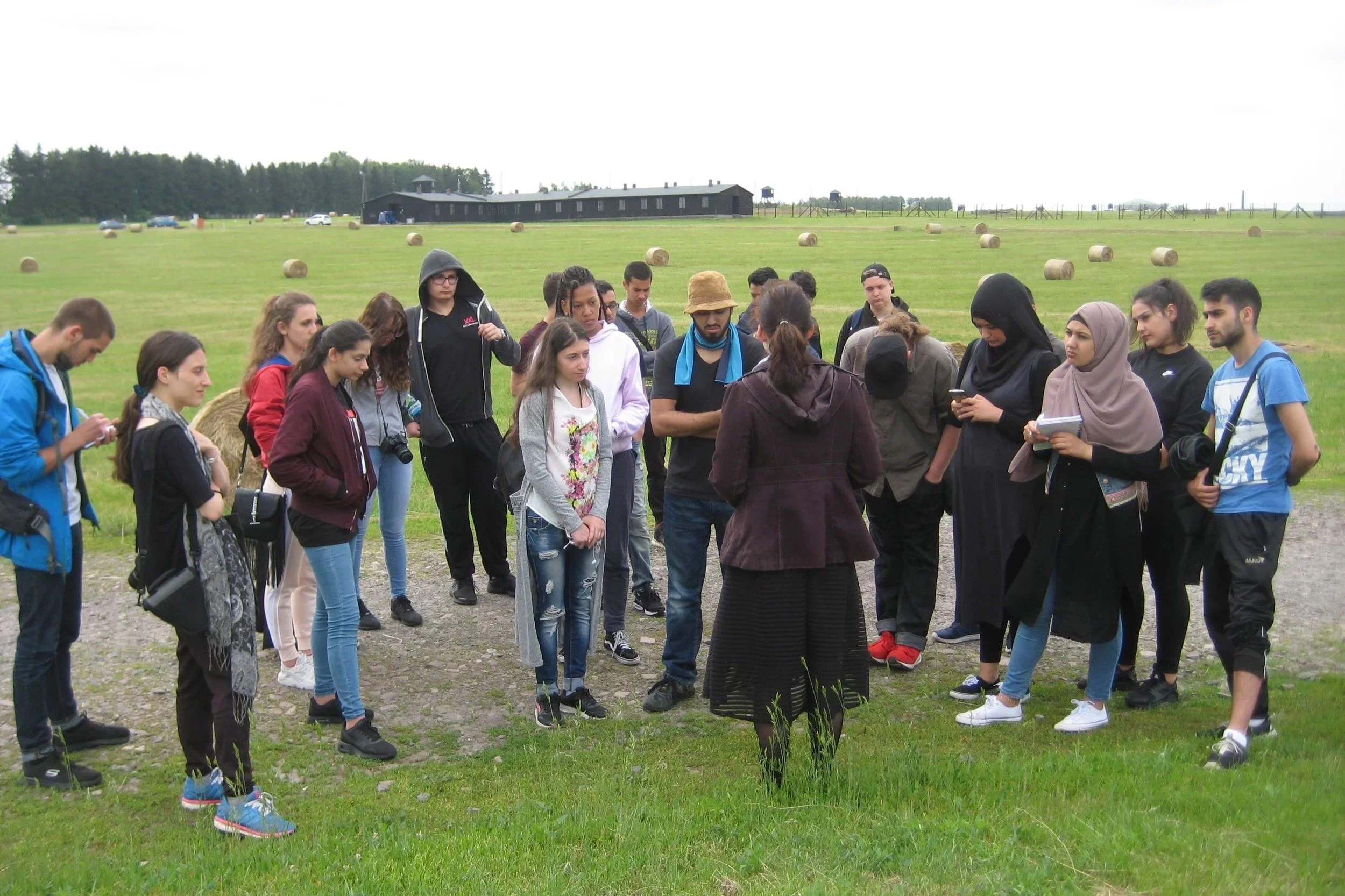Sabeth Schmidthals
If you visit the site of the former Moabit Freight Station in Berlin, you will find a small park, a preserved length of train tracks, and an eight-foot rectangular column explaining what happened here.
You might also find the members of AG Erinnern, the Remembrance Working Group, and their teacher, Sabeth Schmidthals, sharing stories of individuals who passed through the station. If it happens to be International Holocaust Remembrance Day, the park likely will be decorated with large flower bouquets, and individuals will be invited to lay a flower on the tracks. If it happens to be November 7, the anniversary of the Kristallnacht pogrom, the tracks may be lit with candles.
The Moabit Freight Station was the largest deportation station in Germany during the Nazi era; some 35,000 men, women, and children were sent from this station to ghettos and extermination camps. Until 2017, the site was largely unknown, with only a small marker indicating the horrific history that occurred there. Now, as it did then, a high school stands directly across the street. The Theodor Heuss Community School is home to Schmidthals and the students and alumni who make up the Remembrance Working Group.
Today, the station site is a living memorial thanks to the efforts of the Remembrance group. Schmidthals and the group played a role in the planning and creation of the park, they have researched the lives of people who were deported here, and they frequently make public presentations about their findings to visitors, school groups, and community members.
Remembrance, founded in 2015, is filled with young people dedicated to telling these stories and to using their work to counter antisemitism, racism, and xenophobia.
But, says Schmidthals, a 2020 Obermayer Award winner and a participant in Widen the Circle’s 2022 Berlin Fellowship, her students haven’t always been so passionate about this history.
New Generation, New Approach
As a young adult, Schmidthals had a job working for a charitable organization. It involved taking young volunteers to visit Holocaust memorials at Majdanek and Auschwitz, two camps in Poland.
“For all of us, not only the volunteers, it was hard to be there and to listen to what the former prisoners told us because for us, I think, the approach to history was the question: What did my grandparents do at that time? Somehow we felt responsible, even sometimes guilty for what happened. And our aim was to feel responsible that it would never happen again.”
When she became a history teacher, that question and that feeling had a strong impact on her teaching. But it didn’t really connect with her students. “I realized after a few years that for students today, it’s different than it was to me when I was their age, and the way I taught the Holocaust was not working anymore. … It had to change because the Holocaust is a long time ago, and for kids today it’s history. For them, at the first glance it has nothing to do with their life today.”
While that’s true broadly for students in Germany, it’s especially true at Theodor Heuss Community School. Theodor Heuss is a 1,000-student high school where 90 percent of the students come from immigrant families — mostly from Turkey and the Middle East. These families don’t have roots in Germany dating back to the Nazi period, Schmidthals says, “So they don’t feel responsible for German history; they don’t feel guilty about it.”
A touchpoint occurred when the school split her class into two group, students from “real” German families and students from immigrant families. A rift developed, with students from longtime German backgrounds accusing the students from immigrant families of not being respectful of the history, while students from immigrant families countered, “It’s not our history. We have nothing to do with it.”
“For awhile, actually, I stopped talking about the history too much, only [presenting] that part that you have to teach as a history teacher,” Schmidthals says.
But then she started a class project in which students researched their own family, talking to their parents and grandparents and collecting photos. They would then each explain their family background to others in the class. One girl, telling the story of how her family had fled from their home in the Middle East, broke down in tears. “I asked her, is this the first time that you have talked about your family history? She said yes, nobody ever asked me to do it before,” says Schmidthals.
“This was the point where I said OK, my approach to history was because of my family, because I asked questions about my family, and it should be the same for them, that they can ask questions about their families. And when I talk to them about Jewish people, for example, they don’t think first about the Holocaust. They think that their families have had to leave their home country. So I think it is necessary that we have to talk to them about the Middle East conflict first to make them sort of open to deal with the German history.”
That this approach has been immensely successful is clear in the work of the Remembrance Working Group, which Schmidthals formed with her students in 2015, after the class project on family history. The focus of the group, she says, is that “Young people, most of whom were born in Germany but come from families that are not originally from Germany, explore their own identity and try to find an approach to German history, the history of the country to which they feel they belong.”
In addition to researching Nazi victims and doing remembrance work at the Moabit Freight Station site, known as Track 69, the group has traveled widely to learn about differing aspects of the Nazi era and German colonialism. They have been to Israel twice focusing on multiculturalism and identity; to Spain and France focusing on flight and emigration in the past and present; Poland, to visit memorials at Auschwitz and other camps; and to Italy to study resistance to the Nazi regime and German occupiers. In 2023 they travelled to the United States to learn about remembrance practices in the U.S. and to remember the victims of the Holocaust and colonialism, and in 2024 to Belgium for the consequences of colonialism.
Another trip to the U.S. is planned for this July as part of a study of the Triangle of Colonialism, in which people were enslaved and sold from German colonies in Africa, were transported to the U.S., and then raw materials and goods made with slave labor in the U.S. were sent to Germany.
It’s clear from meeting the members that the working group has been impactful on their lives. Says one alum, Christiane Simon, “I’m a strong, independent female, I believe, and I don’t think I would have become that without the [working group]. I think this played a big role in my being…so loud on social justice issues. I really do believe that Ms. Schmidthals changed my life, basically, and I want to give that forward.”
Trip to Poland, 2017





